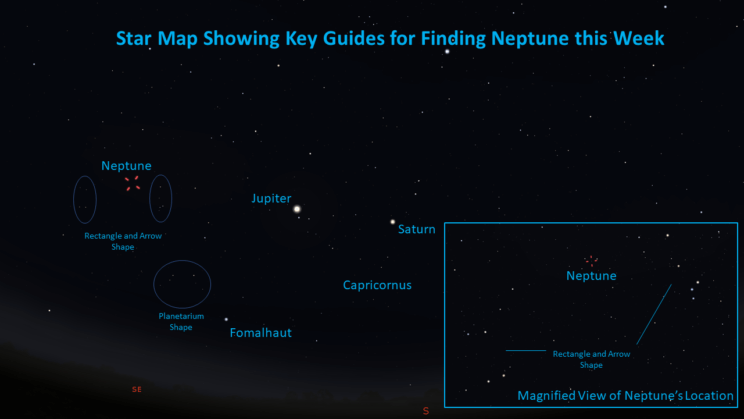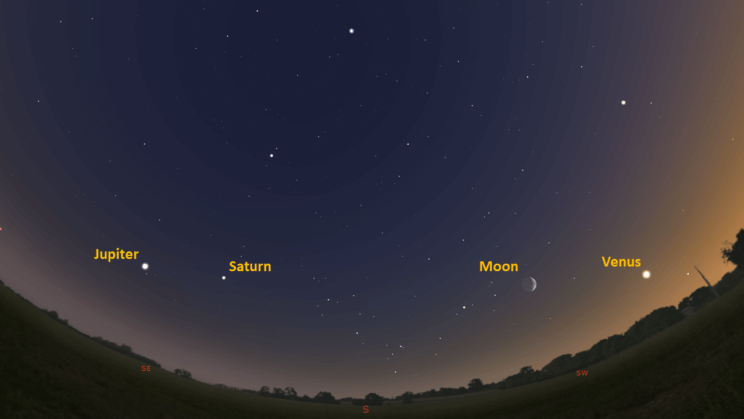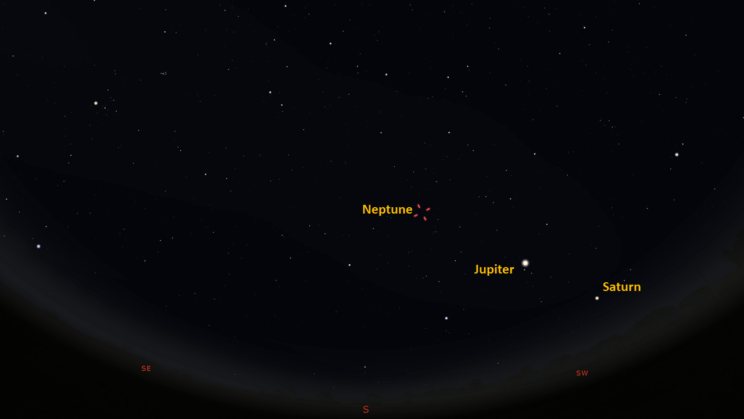This is the Saint Louis Science Center’s NIGHT SKY UPDATE for the week of Friday, September 10, 2021.
Information updated weekly or as needed.
Times given as local St. Louis time, which is Central Daylight Time (CDT). For definitions of terminology used in the night sky update, click the highlighted text. If relying on times posted in Universal Time (UT), St. Louis is -5 hours when CDT.
Public Telescope Viewings
With the changing recommendations from the CDC regarding COVID-19, conversations regarding the return of star parties at the Saint Louis Science Center have begun. We are close to bringing back our public telescope viewings, but a few details still need to be worked out. We will post future updates as we learn more about when we can bring back telescope viewings.
Observing Highlight of the Week

Neptune will reach opposition on September 14, 2021. With optical aid, Neptune can be found in Aquarius.
Image created using Stellarium.
This week we will highlight the planet Neptune. On September 14, 2021, Neptune will reach opposition. This means Neptune will be at its best for backyard observers this year. That said, you will need a telescope or binoculars to find it because the brightest Neptune gets this year is 7.8 magnitude. Even though opposition occurs on a specific date, the planet will stay at 7.8 magnitude for the next couple of months.
Neptune was discovered in 1846. It was mathematically predicated by mathematician Urban Jean Joseph Le Verrier and would later be found by astronomers J. G. Galle and H. L. d’Arrest at the Berlin Observatory. The ice giant Neptune is about four times larger than Earth. At 30.1 astronomical units, Neptune takes 165 years to orbit the Sun. Since its discovery, Neptune has only been observed to completed one full orbit. The deep blue color of Neptune is the result of how sunlight is affected by its atmosphere. Methane in Neptune’s atmosphere effectively absorbs red and IR wavelengths of light from the Sun.
To find Neptune, you will need a telescope or moderate aperture binoculars mounted on a tripod. You will also need a good map of the star field Neptune is located in. Currently, you can find Neptune in the constellation Aquarius. This constellation can be difficult to spot, so a better place to start is the constellation Capricornus. To find this constellation, look south around 10 p.m. for a bright smile shape of stars. This is also where you can find Jupiter and Saturn, which will be the brightest objects seen in the south. If you can find Jupiter, the brightest star you see south of the planet is called Fomalhaut. Once here, look north and east of Fomalhaut for six stars in the shape of the planetarium building; you are now in Aquarius. Once you can find Aquarius, things will get challenging. About 6° north of the planetarium shape is the star called Skat. From here, begin to pan east and you will find an arrow shape of stars and then on to a rectangle shape of stars. Neptune is located between these two groups.
If viewing conditions are poor, finding Neptune in our light pollution can be challenging. If you can find Neptune, track it over the next few months and you will see it like other planets, Neptune is shifting amongst the background stars. Neptune is currently exhibiting retrograde motion and will continue to do this until December 1, 2021. This apparent backwards motion occurs as Earth catches up to Neptune in our orbit and then passes it by. Retrograde motion is just an illusion.
The Sun and Moon

The Moon as seen from the International Space Station, on July 31, 2011.
Credit: NASA
Sunrise is at 6:37 a.m. on Friday, September 10, and sunset is at 7:16 p.m., providing us with about 12 hours and 40 minutes of daylight. Even after sunset, the light from the Sun will dimly illuminate our sky for roughly 1 hour and 30 minutes. This period is called twilight, which ends around 8:47 p.m. this week. For those with a sundial, local noon occurs around 12:57 p.m. this week.
| Day | Sunrise | Sunset |
|---|---|---|
| 2021-09-10 | 6:37 a.m. | 7:16 p.m. |
| 2021-09-11 | 6:38 a.m. | 7:15 p.m. |
| 2021-09-12 | 6:39 a.m. | 7:13 p.m. |
| 2021-09-13 | 6:40 a.m. | 7:12 p.m. |
| 2021-09-14 | 6:41 a.m. | 7:10 p.m. |
| 2021-09-15 | 6:42 a.m. | 7:08 p.m. |
| 2021-09-16 | 6:43 a.m. | 7:07 p.m. |
| 2021-09-17 | 6:43 a.m. | 7:05 p.m. |
| 2021-09-18 | 6:44 a.m. | 7:04 p.m. |
Moon
Moonrise for Friday, September 10 occurred at 9:24 a.m. and moonset occurs at 9:07 p.m. On Friday, September 10 the Moon will exhibit a waxing crescent phase with about 11% of the lunar disk illuminated. First quarter moon occurs on September 13 at 2:39 p.m.
International Space Station (ISS) Observing

Visible passes of ISS from St. Louis for the week of September 10 occur during morning and evening hours. The best passes this week occur on the morning of September 12 and the evenings of September 15 and 18. Use the table below for information about these and other visible passes this week.
Catch ISS from St. Louis starting Friday, September 10
| Date | Starts | Max. altitude | Ends | |||||||
|---|---|---|---|---|---|---|---|---|---|---|
| Time | Alt. | Az. | Time | Alt. | Az. | Time | Alt. | Az. | ||
| 12 Sep | -3.4 | 04:49:50 | 65 | NE | 04:49:50 | 65 | NE | 04:53:11 | 10 | ESE |
| 13 Sep | -2.4 | 05:39:06 | 21 | SW | 05:39:22 | 21 | SW | 05:42:00 | 10 | S |
| 14 Sep | -2 | 19:56:19 | 10 | SSE | 19:58:18 | 15 | SE | 19:58:49 | 14 | ESE |
| 14 Sep | -0.8 | 21:31:30 | 10 | WSW | 21:31:53 | 13 | WSW | 21:31:53 | 13 | WSW |
| 15 Sep | -3.9 | 20:44:20 | 10 | SW | 20:47:41 | 87 | SE | 20:47:47 | 84 | E |
| 16 Sep | -3.5 | 19:57:24 | 10 | SSW | 20:00:38 | 47 | SE | 20:03:23 | 14 | ENE |
| 16 Sep | -0.9 | 21:34:53 | 10 | W | 21:36:25 | 19 | WNW | 21:36:25 | 19 | WNW |
| 17 Sep | -2.1 | 20:47:18 | 10 | W | 20:50:22 | 32 | NNW | 20:51:46 | 23 | NNE |
| 18 Sep | -3 | 19:59:55 | 10 | WSW | 20:03:12 | 51 | NW | 20:06:30 | 10 | NE |
Magnitude (Mag): The Measure of brightness for a celestial object. The lower the value is, the brighter the object will be.
Altitude (Alt): The angle of a celestial object measured upwards from the observer’s horizon.
Azimuth (Az): The direction of a celestial object, measured clockwise from an observer’s location with north being 0°, east being 90°, south being 180° and west being 270°.
For information about ISS flyovers and other visible satellites, visit www.heavens-above.com
Detailed information regarding all unmanned exploration of our universe, missions past, present, and planned, can be found at Jet Propulsion Laboratories:
The Visible Planets

Looking South, at 7:50 p.m. September 11, 2021
Credit: Stellarium, EG

Looking South, at 2:00 am, September 12, 2021
Credit: Stellarium, EG
This week, three naked eye planets are visible. Venus can be found in the west after sunset. Jupiter and Saturn can be found in the southeast after sunset
Mercury
Mercury has started another evening apparition but this one will be tough. Even though Mercury is bright enough to see naked eye, it never strays far from where the Sun is found. Additionally, the angle of the ecliptic we see at sunset right now is decreasing meaning even when Mercury reaches maximum elongation, on September 13, 2021, it will not be seen very high above the horizon.
Venus
Venus is well into another evening apparition. By 7:36 p.m., Venus will be about 13° above the western horizon. Venus will set at 8:50 p.m. As 2021 continues, Venus will continue to elongate from the Sun until October 29 when it reaches maximum eastern elongation. After this date Venus will start to head back towards the Sun as it approaches inferior conjunction on January 8, 2022.
Jupiter
Jupiter has passed opposition and as such will be visible about 30 minutes after sunset. Look for Jupiter in the southeast as it starts to darken outside. Jupiter sets at 4:38 a.m. tomorrow morning and will set about 30 minutes earlier each week. Jupiter reaches superior conjunction on March 5, 2022. This means we can count on seeing Jupiter in the south for the rest of this year and well into 2022.
Saturn
Saturn is past opposition which means it will be visible about 30 minutes after sunset. Right now, it can be found in the southeast after sunset, but as we continue through the year, Saturn will set about 30 minutes earlier each night. Saturn sets at 3:14 a.m. Saturn will reach superior conjunction on February 4, 2022.
James S. McDonnell Planetarium
Night Sky Update: September 10-September 18, 2021






